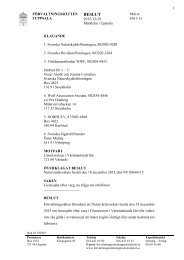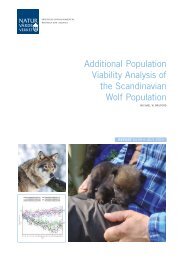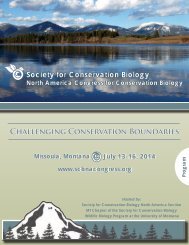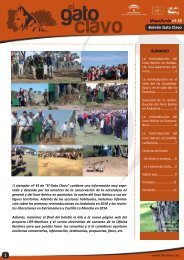1oC3Dbk
1oC3Dbk
1oC3Dbk
Create successful ePaper yourself
Turn your PDF publications into a flip-book with our unique Google optimized e-Paper software.
For Save Our Species (SOS) funded plant projects, the PCSC<br />
has been working with the working group to include assessed<br />
plant groups in the strategic direction for funding. Cycads were<br />
included in 2012 and both cycads and conifers were included in<br />
2013, leading to the funding of eight conservation projects<br />
involving cycads and conifers ranging from 25,000 to 64,000<br />
CHF per project.<br />
The next meeting of the PCSC will probably take place in<br />
September 2014, linked to the Botanists of the 21st Century<br />
conference being organized by UNESCO in Paris. We are also<br />
planning to participate in the World Parks Congress, to raise the<br />
profile of plant conservation in protected areas. Our website can<br />
be accessed here.<br />
John Donaldson<br />
Chair, Plant Conservation Sub-Committee<br />
Marine Conservation Sub-Committee (MCSC)<br />
The core purpose of the MCSC is to connect and facilitate on<br />
marine and ocean matters across IUCN; including regional<br />
offices, focal points and with IUCN partners.<br />
During 2013, we convened several meetings and advanced<br />
priority areas of the MCSC. At the Specialist Group (SG) Chairs<br />
meeting in the United Arab Emirates in early 2013, we convened<br />
fish-related marine SGs as well as all marine SGs, to strengthen<br />
connections between groups and to identify key concerns and<br />
issues. In December we met with MCSC membership,<br />
reconstituted for the new quadrennium. Our focus was to<br />
advance our core areas of communication, bycatch, trade,<br />
wildlife spectacles and positive change for threatened marine<br />
species.<br />
Areas being developed further include better engagement with<br />
Regional Fishery Management Organizations for threatened<br />
species of commercial importance; support for the ongoing<br />
IUCN SSC Global Marine Species Assessment, especially<br />
building on the outcomes of assessments, and integrating<br />
species into spatial planning, and encouraging collection of<br />
trade data for commercial species. Ongoing work involves<br />
The Marine Conservation Sub-Committee at IUCN HQ, December 2013.<br />
various engagements with other marine SGs and SSC subcommittees,<br />
especially those of Conservation Planning,<br />
Invertebrates, Invasive Species and Sustainable Livelihoods. We<br />
also contribute to KBA (Key Biodiversity Areas) discussions in<br />
relation to marine species. Specific projects address bycatch<br />
species, building on three reviews already completed and<br />
considering a number of IUCN Resolutions on the issue. We<br />
would like to see a more integrated—One IUCN—marine<br />
programme during the current quadrennium.<br />
We produce, with the support of the Global Species<br />
Programme, a Marine Species Newsletter and this will be<br />
shared via the new Union Portal.<br />
Yvonne Sadovy de Mitcheson and Claudio Campagna<br />
Co-Chairs, Marine Conservation Sub-Committee<br />
IUCN Red List Committee (RLC)<br />
Introduction<br />
The IUCN Red List Committee is the key decision-making body<br />
that provides oversight and guidance for The IUCN Red List of<br />
Threatened Species. The IUCN Red List Committee sets the<br />
standards of scientific quality for the Union’s work on<br />
biodiversity assessments, develops guidelines on the<br />
application of these standards, develops a strategy for<br />
effectively expanding taxonomic and geographic coverage,<br />
advises and assists uptake of IUCN Red List data in decisionmaking,<br />
and builds collaboration with other organizations<br />
working on biodiversity assessments. The IUCN Red List<br />
Committee meets in-person once per year; inter-sessionally,<br />
much of the work is conducted via email, virtual meetings, or in<br />
separate meetings of its working groups.<br />
Composition and structure<br />
The IUCN Red List Committee is designed to include<br />
representatives of the three pillars of IUCN: the IUCN Species<br />
Survival Commission, the IUCN Secretariat (especially the<br />
Global Species Programme), and The IUCN Red List<br />
Partnership (many of whom are also IUCN Members). Current<br />
IUCN Red List Partners are: BirdLife International; Botanic<br />
Gardens Conservation International; Conservation International;<br />
NatureServe; Microsoft; Royal Botanic Gardens, Kew; Sapienza<br />
University of Rome; Texas A&M University; Wildscreen; and<br />
Zoological Society of London. The IUCN Red List Committee<br />
continues to seek expressions of interest from new Partners,<br />
and has held preliminary discussions with prospective Partners<br />
during 2013.<br />
Much of the active work of The IUCN Red List Committee is<br />
conducted within its working groups. The Red List Technical<br />
Working Group (RLTWG) is the key technical body that strives to<br />
ensure consistency and rigour in the assessment process. The<br />
National Red List Working Group (NRLWG) works to build<br />
linkages between the global IUCN Red List and assessments<br />
done at the national level. In 2013, The IUCN Red List<br />
Committee established two new Working Groups: a Data<br />
Access Working Group (DAWG), to advise on use of IUCN Red<br />
List data in accordance with the Terms and Conditions of Use,<br />
and a Red List Informatics Working Group (RLIWG) to facilitate<br />
better coordination among IUCN Red List Partners and others<br />
on overcoming major technological stumbling blocks.<br />
98 IUCN species Annual Report 2013






